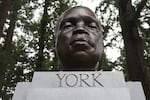
There’s a new monument in Portland’s Mount Tabor Park. It’s a bust of York, the only Black member of the Lewis and Clark Corps of Discovery, and it appeared mysteriously.
Kristian Foden-Vencil / OPB
A statue of the only Black member of the Lewis and Clark expedition that popped up in Portland recently will remain there, at least for now. The memorial to York was mysteriously erected in Mount Tabor Park last weekend atop an empty pedestal for a different statue.
The original monument‚ a memorial to Harvey Scott, the former editor of The Oregonian and an outspoken conservative who fought against women’s suffrage, was torn down last fall amid racial justice protests.
OPB’s “All Things Considered” host Tiffany Camhi spoke to Portland city commissioner Carmen Rubio, who oversees the Portland Parks bureau about the statue of York and what it means for the city.
This interview has been edited for length and clarity. It can be heard in its entirety using the audio player on this article.
Tiffany Camhi: How did you first hear about this statue of York? And what were your initial reactions to it?
Commissioner Carmen Rubio: I first heard about the statue from one of my staff members who told me the art piece had been installed over the weekend. My first immediate reaction was like, ‘Yeah, that’s really great. That’s interesting.’ And I’m curious and I want to know, what were the circumstances around it? So I was initially very intrigued and just instinctively supportive.
Camhi: Several monuments and statues were toppled amid last year’s racial justice protests. These were statues that celebrated white presidents and other civic leaders. A lot of these people have legacies that include imperialism, perpetuating white supremacist culture and, in many cases, just overt racism. In your opinion, is tearing down statues like these part of peaceful protest?
Rubio: I think that we need to look really broadly when we think about that question because when we look back at 2020 it really was the year of reckoning and calls for change to root out racial injustice and white supremacy from institutions that are really meant to protect and serve us. So I think when we are seeing protest art, when we’re seeing larger questions about where we are as a community as a nation, it’s more broadly a demand to be seen and to be reflected where historically Black, Indigenous and people of color community contributions have been exploited, while at the same time we’ve been largely excluded in silence and ignored and kept from participating fully in the full benefits of our economy and our community. It’s a statement about that and that demand to be seen and demand to be recognized and to recognize that rich history of contribution.
Camhi: We know that the York statue will stay in Mount Tabor in the short term. What happens next for it? And in the long term?
Rubio: Long term I would love to see it stay. I would love to see what we can re-envision together about really creating an accessible process that actually invites more stories and invites more history and broadens our understanding of what historical significance means in this city. I would definitely like to see all of our stories reflected and fully embraced by the city.
Camhi: There is a counterargument out there from some people saying that there is a process for putting up monuments in public places and keeping something like this York statue even temporarily is establishing a precedent that could be used by other groups in the future. Do you have a response to that?
Rubio: As communities, we’re evolving and changing, and we’re slowly building and rebuilding systems that were built and created at a time where they were excluding people like me from even participating. [They prevented] people from Black and Indigenous communities and communities of color from participating in those very same processes. Those processes were not designed for us and they need to evolve to include us as well.
This art is a reflection of where we are today. I like that it demands to be heard. And it’s a real-time demonstration of the important role that is placed in elevating civic discourse and telling our stories, and especially the ones that have been held down. These stories, no matter how hard people try to hold them down, they always rise, and they demand to be told.